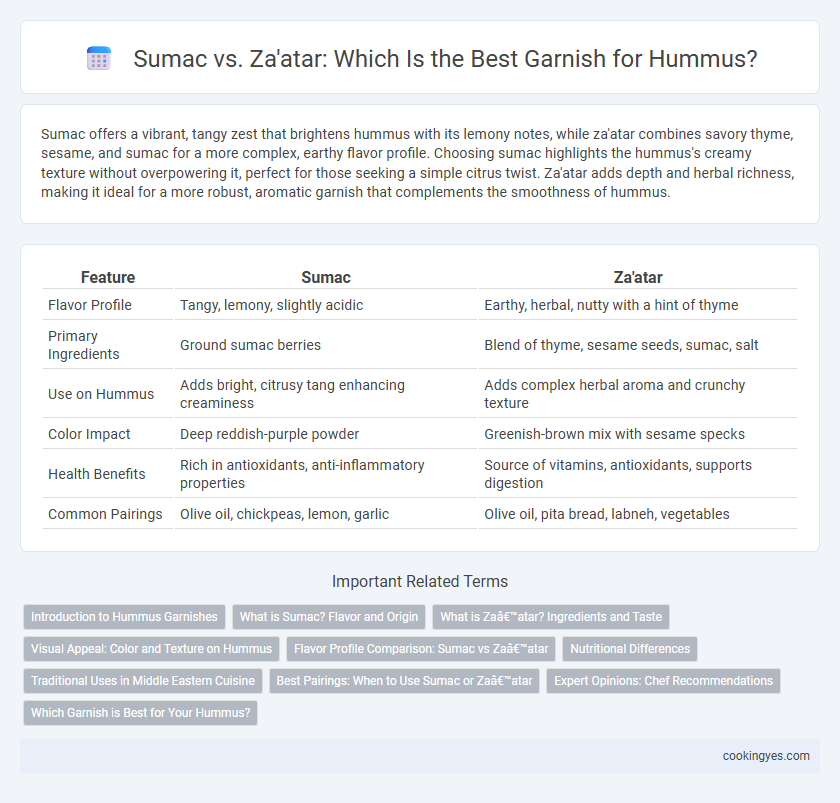Sumac offers a vibrant, tangy zest that brightens hummus with its lemony notes, while za'atar combines savory thyme, sesame, and sumac for a more complex, earthy flavor profile. Choosing sumac highlights the hummus's creamy texture without overpowering it, perfect for those seeking a simple citrus twist. Za'atar adds depth and herbal richness, making it ideal for a more robust, aromatic garnish that complements the smoothness of hummus.
Table of Comparison
| Feature | Sumac | Za'atar |
|---|---|---|
| Flavor Profile | Tangy, lemony, slightly acidic | Earthy, herbal, nutty with a hint of thyme |
| Primary Ingredients | Ground sumac berries | Blend of thyme, sesame seeds, sumac, salt |
| Use on Hummus | Adds bright, citrusy tang enhancing creaminess | Adds complex herbal aroma and crunchy texture |
| Color Impact | Deep reddish-purple powder | Greenish-brown mix with sesame specks |
| Health Benefits | Rich in antioxidants, anti-inflammatory properties | Source of vitamins, antioxidants, supports digestion |
| Common Pairings | Olive oil, chickpeas, lemon, garlic | Olive oil, pita bread, labneh, vegetables |
Introduction to Hummus Garnishes
Sumac enhances hummus with its vibrant, tangy flavor and deep red hue, providing a citrusy contrast that brightens the dish. Za'atar offers a herbal, earthy complexity from thyme, sesame seeds, and sumac, adding a nutty aroma and slightly savory twist. Both garnishes elevate hummus by intensifying its taste profile and visual appeal, making them essential options for authentic Middle Eastern presentations.
What is Sumac? Flavor and Origin
Sumac is a deep red spice made from ground berries of the wild sumac plant native to the Middle East and Mediterranean regions, known for its tangy, lemony flavor that adds a vibrant acidity to hummus. It enhances the creamy texture of hummus with a subtle fruity tartness, making it a popular garnish in Middle Eastern cuisine. Unlike za'atar, which blends herbs, sesame, and sumac, pure sumac offers a straightforward, bright citrus-like note ideal for balancing hummus's rich, nutty taste.
What is Za’atar? Ingredients and Taste
Za'atar is a Middle Eastern spice blend consisting of dried thyme, oregano, sumac, toasted sesame seeds, and salt, known for its earthy, tangy, and slightly nutty flavor. Its unique combination enhances hummus by adding a complex, aromatic profile that complements the creamy texture of the chickpea base. Unlike sumac's sharp, lemony tartness, za'atar provides a well-rounded herbaceous depth, making it a versatile garnish for traditional and modern hummus recipes.
Visual Appeal: Color and Texture on Hummus
Sumac enhances hummus with a vibrant reddish hue and a fine, powdery texture, creating a striking contrast against the creamy beige base. Za'atar, composed of dried herbs, sesame seeds, and sumac, adds a greenish-brown speckled appearance and a coarser texture, offering a rustic and earthy visual appeal. Choosing sumac emphasizes bright color contrast, while za'atar provides a textured, herbal garnish that enriches both color depth and visual complexity.
Flavor Profile Comparison: Sumac vs Za’atar
Sumac offers a tangy, lemony brightness that enhances hummus with a subtle sour note, making it ideal for adding a fresh and vibrant flavor. Za'atar combines earthy thyme, toasted sesame seeds, and a hint of oregano, imparting a complex, herbal, and nutty richness that deepens the hummus' taste profile. Choosing sumac highlights citrusy sharpness, while za'atar emphasizes aromatic, savory layers, each transforming hummus into a distinctive Mediterranean delicacy.
Nutritional Differences
Sumac is rich in antioxidants and vitamin C, which contribute to immune support and anti-inflammatory benefits, while za'atar contains a blend of herbs, sesame seeds, and sumac, offering a higher content of fiber, calcium, and iron that support digestion and bone health. Za'atar's nutritional profile includes thymol and carvacrol, compounds known for antimicrobial properties, whereas sumac primarily provides a tangy flavor with fewer calories and carbs. Choosing between sumac and za'atar as a hummus garnish depends on desired health benefits--sumac emphasizes antioxidant intake, while za'atar improves mineral and fiber consumption.
Traditional Uses in Middle Eastern Cuisine
Sumac is traditionally used in Middle Eastern cuisine for its tangy, lemony flavor that enhances the earthy taste of hummus, often sprinkled on top to add vibrant color and a zesty finish. Za'atar, a blend of dried thyme, sesame seeds, sumac, and salt, introduces a herby and nutty complexity to hummus, reflecting its deep roots in Levantine culinary traditions. Both spices serve as classic garnishes, with sumac emphasizing acidity and za'atar providing aromatic depth, preserving the authentic character of Middle Eastern hummus.
Best Pairings: When to Use Sumac or Za’atar
Sumac offers a tangy, lemony flavor that enhances hummus with bright acidity, making it ideal for lighter, fresh toppings like chopped tomatoes or cucumbers. Za'atar, a blend of thyme, sesame seeds, and sumac, provides an earthy, herbal depth that pairs well with roasted vegetables or warm pita bread served alongside hummus. Use sumac when seeking a sharp, citrusy contrast and za'atar for a complex, savory garnish that complements rich, hearty accompaniments.
Expert Opinions: Chef Recommendations
Chef experts recommend sumac for a tangy, lemony zest that brightens the creamy texture of hummus, enhancing its natural flavors without overpowering them. Za'atar adds an earthy, herby aroma that complements hummus with a complex blend of thyme, sesame seeds, and sumac, favored for its Middle Eastern authenticity. For a balanced garnish, chefs often suggest a sprinkle of sumac for simplicity or za'atar for a more robust, traditional taste experience.
Which Garnish is Best for Your Hummus?
Sumac offers a tangy, lemony flavor that brightens the creamy texture of hummus, enhancing its natural earthiness. Za'atar combines thyme, sesame seeds, and sumac, providing a complex, herbaceous, and nutty taste that adds depth and aromatic intensity. Choosing between sumac and za'atar depends on whether you prefer a simple, zesty accent or a more robust, layered flavor profile for your hummus.
Sumac vs Za’atar for Hummus Garnish Infographic

 cookingyes.com
cookingyes.com